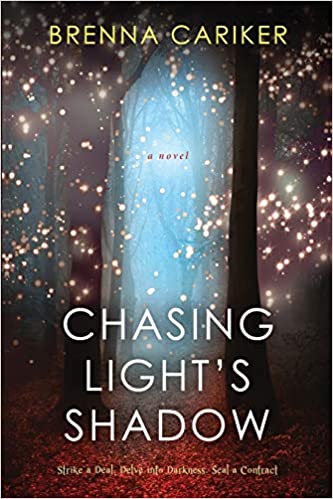Life is pretty dark for seventeen-year-old Eloise Wylde. Her alcoholic dad is her only family, and she makes a living by helping him cheat during poker games. But when Eloise makes a mistake, things get darker quickly and their mark, Randy, issues an ultimatum: either Eloise counts cards for Randy, or her Dad dies.
From the first page, Cariker proves herself a master of imagery. The opening scene in Randy’s apartment is truly grim, gritty and depressing. Eloise and her dad are barely scraping by, and there isn’t much light or happiness in their lives. The scene created a very visceral avoidance reaction in me: I didn’t want to be there, and all I could think was, “God. What a horrible existence.”
The role reversal in Eloise’s relationship with her father is also starkly apparent, and Cariker illustrates it quite poignantly in several places throughout the story. As she is running from Randy, Eloise comes across a mother with her son – the foil to the dynamic in her own relationship with her father – and she thinks: “Maybe I could ask her for help. Maybe she would take me home with her and help me come up with a plan. Mothers did that right? They had an instinct to help.” This point is hugely important in the development of Eloise’s character. She truly has no experience with a nurturing mother figure, or really even a true parental figure at all. Instead, she is the mother and her father the child. Eloise takes care of her father, makes the plans and then executes them to make sure their family survives. This point is further illustrated when Eloise thinks back to a hamburger eating contest in which her father took part. “And here I was, going along with it because that’s what I did. I had to. I had to keep him out of trouble and make sure he would be alright.”
Eloise is deeply unhappy with her struggling-to-survive existence with her father, but it’s what she knows. For Eloise, teenage normalcy is a dream. What’s more, she doesn’t even dream of perfection or riches or any number of the other things “normal” teenage girls dream of – for her, “normal” would be perfection. “I imagined myself for one moment lounged against the brick wall next to him. We’d both laugh together as we made fun of the business people who were walking home in their stiff suits. Maybe I’d have my first kiss when he walked me home. It’d taste like cigarettes and gum.”
At the depth of her despair, when Eloise is running from the darkness that is Randy and trying desperately to figure out how she’ll save both herself and her father, like magic, she sees a “light” and has hope – just as she is about to give up. This allegory of Light is persistent through the story, and it’s incredibly well-done.
Upon her introduction to the magical world, when she meets the fairies, Eloise thinks, “It felt nice to be reminded of how magical this world was – especially after witnessing so much of the scary side”, and that, right there, I think is the epitome of Light’s purpose in her life. Not only does Light show her the “light” by illuminating a whole world that had before been entirely unknown to her, but he does so in a way that manages to both mirror and imitate the character of her father and, in doing so, make her aware of possibilities in life that she never thought available.
“Just like Dad, Light was far from a saint, but the good was there underneath. And I had always been able to see it.” Just as Light is necessary in Eloise’s life to show her the magic that is possible, so too is Eloise necessary to Light – he may have anti-hero qualities, but because of the darkness she has lived through, she can see past and through all of that to the shining qualities beneath.
Overall, I thoroughly enjoyed this book and found it to be a great debut. Cariker did an amazing job with character development and imagery, and I loved the themes she wove into her stories.
That said, I did notice minor grammatical errors and awkward/incorrect word choice that I foresee would be easily overcome in future books with a beta or proofreader. I also found that certain aspects of the story were too convenient – almost as if the lore and plot were shifted to meet the needs of the story, and the author’s presence became obvious and distracting. For example, I found the rule – mentioned several times by characters in trouble – that supernaturals aren’t allowed to so much as frighten humans to be an odd world-building choice and likely more a convenient tool for the author to guide the story where she needed it to go. Again, these are holes and issues that I think would be easily remedied by the addition of a beta reader or beta team to provide some extra eyes.
All in all, I found this story to be a refreshing addition to the YA realm, I’d highly recommend it, and I can’t wait to see what Cariker comes up with next!
Get your copy of Chasing Light’s Shadow now!

No Comments